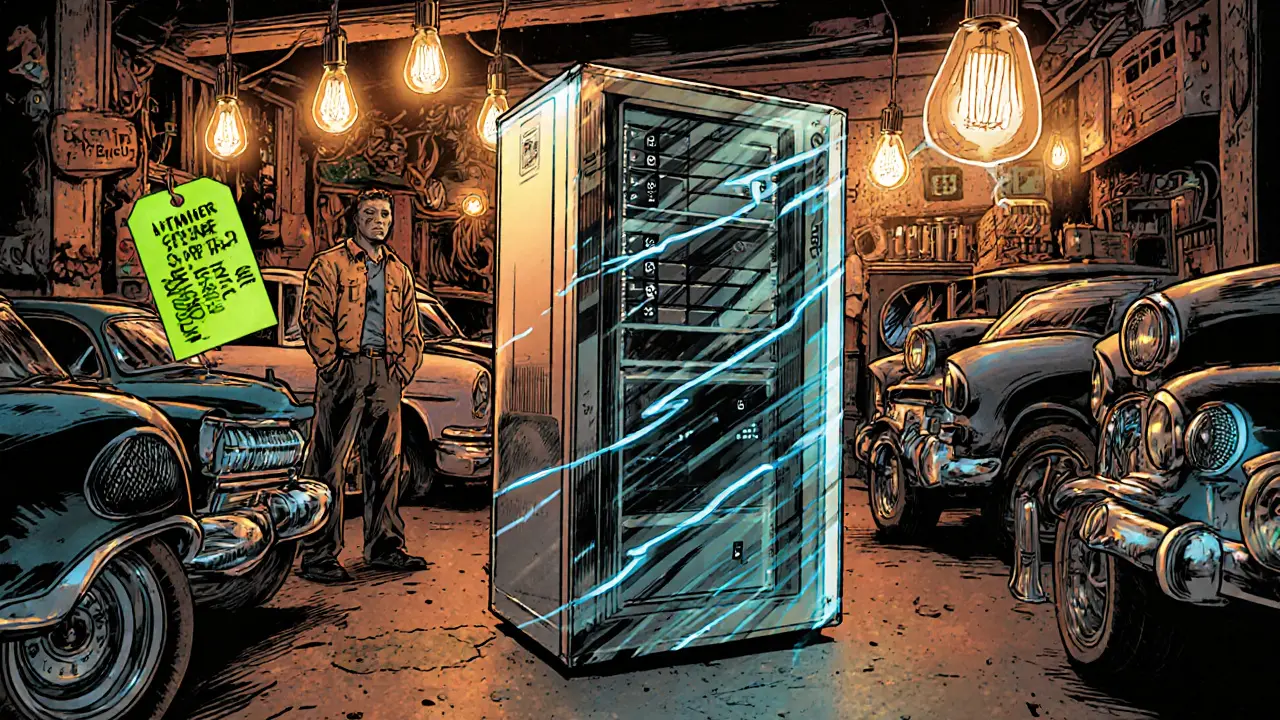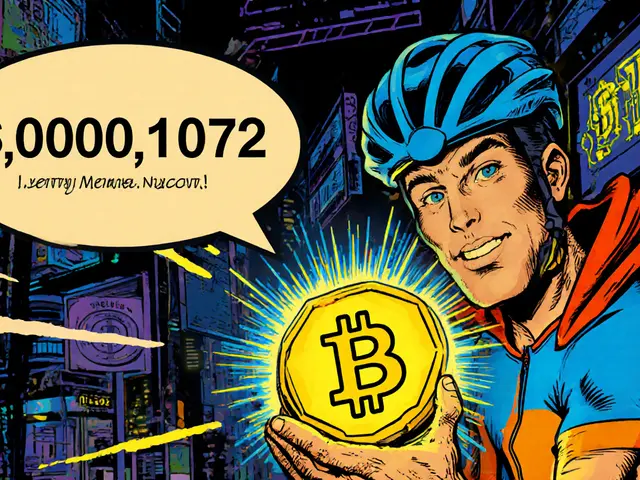
Finding the right mining rig in 2025 feels like shopping for a high‑performance car - you need raw power, fuel efficiency, and a setup that fits your garage. Whether you run a small hobby farm or a professional data‑center, the choices have exploded thanks to new Bitcoin mining hardware purpose‑built ASIC machines designed to solve the SHA‑256 algorithm for Bitcoin mining. Below is a hands‑on guide that cuts through the hype, compares the hottest models, and shows you how to calculate real‑world profit.
How to Choose Mining Hardware in 2025
Three factors dominate any purchase decision:
- Hash rate - measured in terahashes per second (TH/s). More TH/s means more chances to solve a block.
- Energy efficiency - expressed as joules per terahash (J/TH). Lower numbers translate to lower electricity bills.
- Total Cost of Ownership (TCO) - includes purchase price, power cost, cooling infrastructure, and expected lifespan.
In 2025 the market splits into two cooling philosophies: air‑cooled units that are cheap to start but louder and less dense, and hydro‑cooled (liquid‑cooled) rigs that push the performance envelope while staying quiet. Your decision hinges on how much capital you’re ready to invest in power and cooling.
Ultra‑High‑Performance Hydro‑Cooled Leaders
Hydro cooling has become the gold standard for industrial miners. These machines pack the highest hash rates while keeping the J/TH ratio under 15.
- Bitmain Antminer S21e XP Hyd 3U 860TH/s, 11,180W, 13J/TH, 50dB noise, priced at US$17,210
- MicroBT WhatsMiner M66S++ 356TH/s, 5,518W, 15J/TH, MSRP US$8,660
- Auradine Teraflux AH3880 600TH/s, 8,700W, 14J/TH, US$7,800
- Bitdeer SealMiner A2 Pro Hyd 500TH/s, 7,450W, 15J/TH, US$3,958
These units demand a dedicated cooling loop, a high‑capacity pump, and a power feed capable of at least 50amps at 220V per rig. Expect an additional $2,000‑$5,000 for plumbing and heat‑exchanger hardware.
Mid‑Range Hydro Options with Strong Value
If you want the efficiency boost without the $17k price tag, look at the following models:
| Model | Hash Rate (TH/s) | Power (W) | Efficiency (J/TH) | Price (US$) |
|---|---|---|---|---|
| WhatsMiner M63S Hydro 390T | 390 | 5,100 | 13 | 13,699 |
| WhatsMiner M63 Hydro 366T | 366 | 4,800 | 13 | 11,799 |
| Antminer S21 XP Hyd (500TH) | 500 | 5,500 | 11 | 12,700 |
All three deliver sub‑15J/TH numbers, making them profitable in locations where electricity costs sit between $0.08 and $0.12 perkWh.
Best Air‑Cooled Picks for Smaller Operations
When ceiling height or budget prevents liquid loops, air‑cooled rigs remain viable. They are louder (70‑76dB) and consume a bit more power per TH, but the upfront cost is modest.
- Antminer S21 XP 270TH/s, 3,645W, 13.5J/TH, US$7,599
- Antminer S21 Pro 234TH/s, 3,510W, 15J/TH, US$6,500 (estimated)
- WhatsMiner M66S 310TH/s, 4,200W, 13.5J/TH, US$7,200
These machines fit in a 19‑inch rack and need only a robust ventilation fan. Plan for 3,000‑5,000W of heat removal per unit - a standard commercial HVAC system can handle a cluster of up to ten.

Calculating Real‑World Profit: A Simple TCO Worksheet
Plug your numbers into the following steps to see if a rig will actually make money:
- Determine total power draw (W) and multiply by your local electricity rate (USD/kWh). Example: 11,180W × $0.10/kWh = $1.118 per hour.
- Calculate daily electricity cost: $1.118 × 24h = $26.83.
- Estimate daily Bitcoin reward based on current network difficulty (use an online calculator). For a 860TH/s miner at today’s difficulty, the expected daily BTC is about 0.0012BTC (~$45 at $37,500/BTC).
- Subtract daily electricity cost: $45 - $26.83 = $18.17 net profit per day.
- Divide the purchase price by daily profit to get break‑even days. $17,210 ÷ $18.17 ≈ 947 days (≈2.6years).
If your electricity rate exceeds $0.12/kWh, the break‑even period extends beyond three years, making the rig less attractive.
Setup, Cooling, and Maintenance Tips
Getting a hydro‑cooled miner up and running takes more planning than plugging in an air‑cooled box.
- Power wiring: Use 10mm² copper conductors for 50‑amp loads, and install a dedicated circuit breaker.
- Cooling loop: Route coolant from a closed‑loop reservoir through a high‑flow pump (≥3L/min) into the miner’s heat exchanger, then to a radiators or a water‑chiller.
- Monitoring: Deploy a simple RaspberryPi with Grafana to track hash rate, temperature, and power draw in real time.
- Firmware updates: All major brands release quarterly firmware patches. Keep a backup of the original image before flashing.
- Safety: Install surge protectors and an emergency shut‑off switch accessible within 2meters of the rack.
Air‑cooled units merely need proper airflow - keep intake filters clean and maintain a 20°C ambient temperature to avoid throttling.
What’s Coming After 2025?
Manufacturers are already teasing the next wave:
- Bitmain’s upcoming S22 series promises 400TH/s air‑cooled performance with sub‑12J/TH efficiency (expected Q22026).
- MicroBT’s M7x line is being designed for immersion cooling, which could cut power use by another 10‑15%.
- Chip fabs moving to 3nm nodes mean a potential 25‑30% boost in efficiency, but supply constraints may keep prices high.
For now, the 2025 lineup gives you the most efficient machines on the market, and selecting the right tier balances upfront spend with long‑term profit.
Frequently Asked Questions
Which miner gives the best hash‑rate per dollar?
The Bitdeer SealMiner A2 Pro Hyd provides roughly 0.126TH/$, the highest ratio among hydro‑cooled models under $4,000.
Can I run a hydro‑cooled miner in a residential garage?
It’s possible, but you’ll need a dedicated 220V circuit, a water‑chiller, and a noise‑proof enclosure to meet typical homeowner association rules.
How does electricity cost affect profitability?
Machines with ≤15J/TH stay profitable up to $0.12/kWh. Above that, only the most efficient hydro rigs (≈11J/TH) can break even.
What warranty does Bitmain offer on the S21e XP Hyd?
Bitmain provides a 12‑month parts‑only warranty, with optional 24‑month extended coverage for an additional fee.
Is it worth buying a miner now or waiting for 2026 releases?
If your electricity rate is low (<$0.08/kWh) and you need immediate capacity, buying a 2025 model makes sense. Otherwise, waiting for the S22’s sub‑12J/TH could improve ROI.






There are 14 Comments
Amy Harrison
Great rundown! 🎉 The S21e XP Hyd looks insane but the efficiency numbers are really exciting. If you can lock in cheap electricity, those profit margins can actually start looking sweet. Keep crushing those hash rates! 🚀
Natalie Rawley
Oh my gosh, this guide is literally the *Bible* of mining hardware! I mean, who even thought we’d see 860 TH/s on a single box? The hype is real and the numbers are *mind‑blowing*. Every serious miner needs one of these bad boys ASAP!!!
Katherine Sparks
Thank you for the detailed guide, it’s very helpful. I especially appreciate the section on cooling loops-very thorough. I have one tiny question about the J/TH rating, but overall great work. (typo: “tho”)
Kimberly Kempken
All this fanfare about hydro‑cooled rigs is just marketing fluff. You’re paying extra for a water system that does nothing more than a fan with a hose. Stick with air‑cooled units unless you have an infinite budget.
Taylor Gibbs
Yo, love how you broke down the costs. I think it’s important to remember that not every garage can handle a 220V setup-some folks need to start smaller. Also, don’t forget the extra cost of the water chillers, they can add up fast.
Rob Watts
Water cooling is overkill for most hobbyists.
Jim Griffiths
For a quick profit calc, just divide the daily BTC reward by the daily electricity cost; if the result is positive, you’re good.
Matt Nguyen
While your simplistic arithmetic may satisfy the layman, it neglects the hidden variables-namely, the inevitable firmware backdoors embedded by major manufacturers to siphon hash power. This is not a conspiracy; it is well‑documented across multiple supply chains.
Cynthia Rice
Power is illusion; the true value lies in the quiet hum of progress.
Shaian Rawlins
Reading through this guide feels like taking a leisurely stroll through a futuristic bazaar where each stall proudly showcases its gleaming ASIC masterpiece. The Antminer S21e XP Hyd, with its staggering 860 TH/s, stands as a towering monument to human ingenuity, reminding us that perseverance can indeed bend the very fabric of digital gold. Yet, behind the impressive specs lies a sobering reminder of the environmental stewardship we must embrace; after all, no miner should thrive at the planet's expense. The hydro‑cooled models, while quieter and more efficient, demand a level of infrastructure investment that can appear daunting for newcomers, but such an investment often pays dividends in longevity and stability. It is essential to weigh the upfront costs against the expected lifespan, especially when electricity rates fluctuate seasonally. Remember, a well‑designed cooling loop not only preserves hardware but also reduces the noise pollution that can disturb a neighbor’s peace. Moreover, the choice between air‑cooled and hydro‑cooled rigs should reflect both the physical space constraints and the long‑term operational goals of the miner. For a small hobbyist, the Antminer S21 XP 270TH/s may be the perfect balance of power and affordability, fitting snugly into a modest garage without requiring a dedicated water chiller. Conversely, large‑scale operations will find the Bitdeer SealMiner A2 Pro Hyd an alluring option, offering a compelling hash‑per‑dollar ratio that can tip the profitability scales in their favor. In any scenario, diligent monitoring via tools like Grafana provides real‑time insights that can preempt costly failures. Lastly, keep an eye on the upcoming releases; the industry’s rapid evolution means today’s best may become tomorrow’s baseline. Staying informed, adaptable, and community‑oriented will ensure that every miner, regardless of scale, can navigate the ever‑shifting tides of Bitcoin mining with confidence and resilience.
Miranda Co
Nice overview but honestly, if you can’t afford the water loop, you’re just wasting money on hype.
mukesh chy
Oh wow, another “expert” telling us to check the J/TH ratio. As if the market isn’t already saturated with these over‑priced toys. Get a real job.
Amal Al.
Indeed, mukesh, the saturation point is evident, especially when one considers the energy consumption, the environmental impact, and the diminishing marginal returns, all of which suggest a need for deeper analysis before further investment.
Eva Lee
From an architectural perspective, the integration of a closed‑loop coolant system introduces a cascade of thermal resistance considerations, necessitating a re‑evaluation of the ASIC’s thermal design power (TDP) envelope to maintain optimal hash‑rate stability.
Write a comment
Your email address will not be published. Required fields are marked *